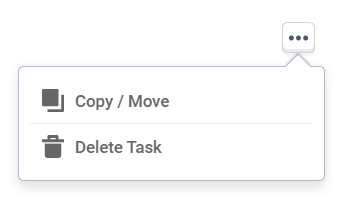Trash Bin for tasks and files
Introduction
Did you ever accidentally delete a task or a file only to have to manually recreate/reupload it? That won't be a problem anymore. Each project now has its own Bin page, where tasks and files stay for 30 days after deletion.
The bin page can be accessed by all project members, but tasks can only be restored by those with permission levels above Guest or Read-Only.
Trash Bin for Tasks
Not everything can be restored. Data like which task list the task belonged to, tags (including for comments), GSync, linked milestones, dependencies, recurrence, followers, and unread notifications will be lost.
Everything else stays title, assignee, progress status, start and due dates, files, comments(including attachments), and custom field values.
How to access Trash Bin for Tasks
To access a project's bin, go to the Tasks page then click the settings icon (1) and select (2)
Restoring Tasks
To restore a task, simply click the 3-dot button next to its name, select Copy/Move, then select the project and task list you want to add it to.
Clicking the 3-dot icon on the task list(Bin) will allow you to:
a. Restore all tasks in the Bin by copying them to a project,
b. Delete all tasks in the bin.
By default. the Copy/Move function for the Bin task list will copy all deleted tasks to a new task in a project of your choosing, but you can also copy/move to an existing task list by clicking on More options(1), then on Copy/Move into existing task list(2).
Trash Bin for Files
- a file will be restored to its folder if it exists or to the root folder otherwise;
- files are stored in the Bin for 30 days;
- we restore all the versions of the file (even file versions deleted before the actual file was deleted and out into the bin). So If you have a file with 5 versions, delete the 3rd version and delete the file later - restoring from the bin will restore all the versions including the 3rd.
What files go in the Files Bin?
The current approach is as follows:
- If a task is deleted it will be in the tasks bin and its files in the files bin
- If a discussion/event/milestone (anything but a task) is deleted - files will NOT be in the Files bin
- If a file in a discussion/event/milestone (anything but a task) is deleted - this file will be in the Files bin
- If a comment is deleted - files will NOT be in the Files bin
- If a file in a comment is deleted - this file will be in the Files bin
Which files a user can see/restore in/from the Files Bin
- a user can see files allowed by permissions (see more how permissions in the Files app work here);
- if a user doesn't have access to the Files app - no access for Files Bin is allowed;
- a user can restore a file if has the right to edit it permission-wise.
Files relations with items/comments they were attached to
During restoration, we check the existence of the item/comment the file belongs to. If the comment exists, we also check the item's existence.
Possible cases here:
- an item is linked to an item - discussion/event/milestone (anything but a task)
- an item exists - link is saved
- an item no longer exists - link is cleared, the restored file appears as uploaded to the Files app directly
- an item is linked to a task
- a task is active - link is saved
- a task is in the Tasks Bin - link is cleared, the restored file appears as uploaded to the Files app
- a file is linked to a comment:
- a comment exists and the item is active - the link is saved
- a comment exists but linked to a task is in the Tasks Bin - link is cleared, , the restored file appears as uploaded to the Files app
- a comment is deleted now - the link is cleared, the restored file appears as uploaded to the Files app
How to access Trash Bin for Files
To access Trash Bin for files, go to the Files application in a project then click the settings icon (1) and select (2).




